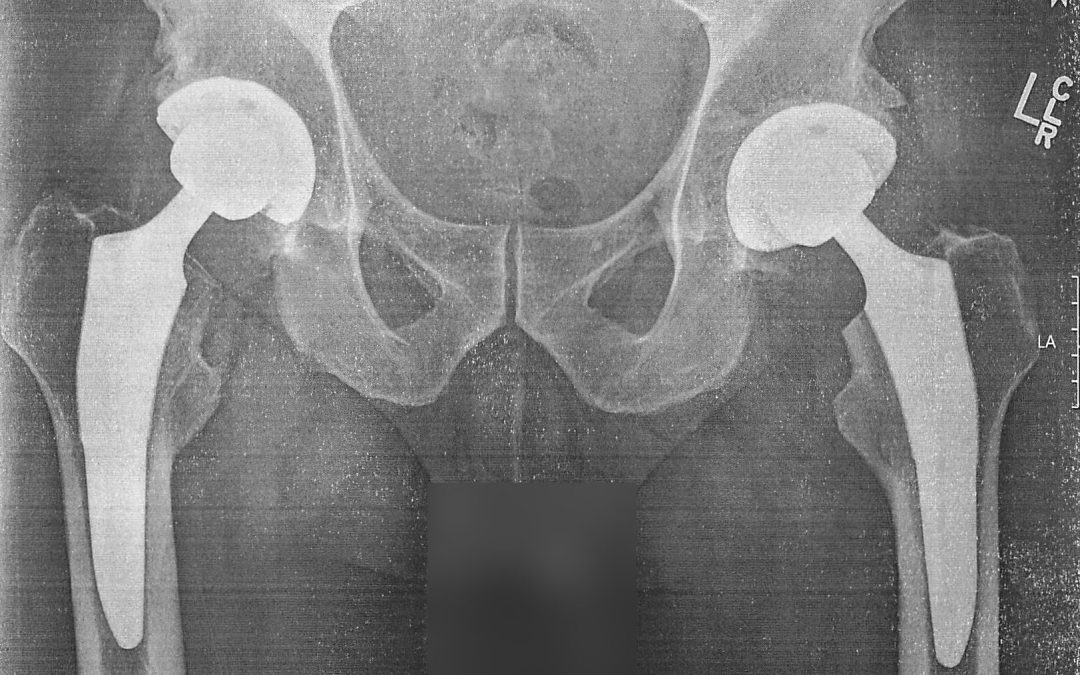After years of procrastination and adaptation, I recently had my second total hip replacement this year. THR is a radical one-way street—there’s no going back. The surgeon sawed off my femoral head, cleaned out the hip socket (with a chisel and drill), and replaced the natural bone and cartilage with a Pinnacle metal liner and Marathon polyethylene cup, a titanium Depuy TRI-LOCK stem, and a ceramic head. All this through a four-and-a-half inch opening. Sewed me back up and sent me on my way. It’s crazy to even think about. It was a heart-wrenching decision to pursue.
But it works.
For close to five years, I had been limping and walking stooped, experiencing pain with every activity including rolling over in bed, and unable to do simple tasks like tying shoes and picking something up off the floor. I managed through a combination of creative positioning, gritting my teeth, handy tools, and ibuprofen.
In March, I had my first hip replaced. After all the trauma to the joint and the body, I walked out of the surgery center just five hours after going under anesthesia. I was on my feet without assistive devices (cane, walker) in a little over two weeks. I was pain free pretty much from day one. I played pickleball at week ten. It was an amazing life change.
Then I had to (got to) do it again on the other hip. With high expectations after my first hip’s success, I had an ominous thought the night before surgery: “What if this one doesn’t go as well? What if I get an infection, the joint doesn’t take, or it just doesn’t work?” Thankfully, my fears were all for naught and this hip is progressing faster than my first one.
I’ve had some time to think about surgery and extreme changes to our lives. There are three typical phases to accepting and pursuing big changes:
- Denial. The first response to most any setback seems to be “It’s not that bad. I can manage. It’ll get better.” You can. And it may. But it’s not your best effort and the longer you go doing things the bad way, the worse they get in the long run.
- Delay. Even after accepting that a change is needed, it takes some time to convince the mind to actually do it. There are always other things to do. There are always higher priorities. The fear of the unknown is a great inhibitor to changing the pain of the known.
- Doing. Either through force of will, the encouragement of a coach or friend, or it gets too bad to tolerate anymore, you take action.
As I had a few weeks to sit inactive and think, I realized this is the process a lot of people go through with speaking. They are disabled with fear. They struggle to complete simple tasks. They hobble and wobble and just get through it. They adapt and soldier through the pain.
There is always something else to do besides working to get better. Even though the fear and poor results aren’t ideal, they are known and we can live with it.
Or maybe, you take action. The pain of changing habits isn’t pleasant. Working to alter behaviors that have become comfortable isn’t always easy. But the long-term advantages are worth the short-term inconvenience.
This applies to so much in life. Budgeting and finances. Healthy eating. Putting others’ interests ahead of our own.
Think long-term. Act now.
Communication Matters. What are you saying?
Want more speaking tips? Check out our Free Resources page and our YouTube channel.
We can also help you with your communication and speaking skills with our Workshops or Personal Coaching.
This article was published in the September edition of our monthly speaking tips email newsletter, Communication Matters. Have speaking tips like these delivered straight to your inbox every month. Sign up today to receive our newsletter and receive our FREE eBook, “Twelve Tips that will Save You from Making a Bad Presentation.” You can unsubscribe at any time.




